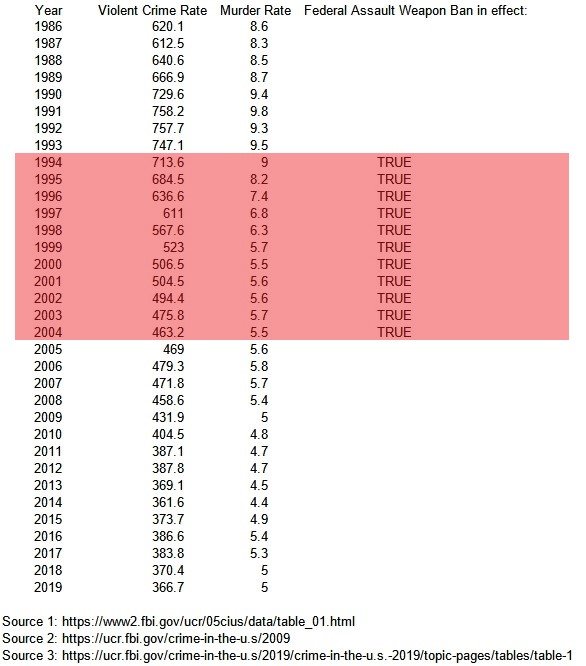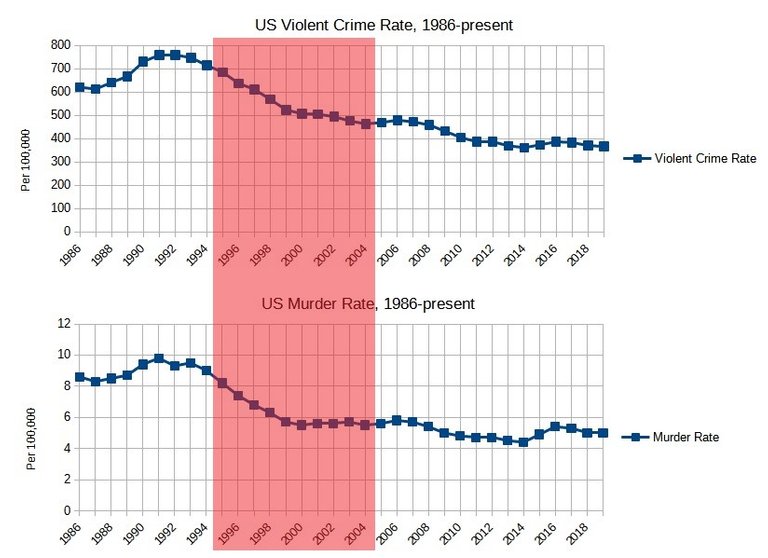Gun control efforts are in the news again here in the United States. The new Democratic majority wants to pass a new version of the 1990s Clinton-era Federal Assault Weapon Ban (AWB) to outlaw, or at least heavily restrict new sales of, modern carbines and standard-capacity magazines.
Let's take an honest look at the data from last time, and see what effect it had before, if any. I made a table and charts in LibreOffice Calc. Behold their magnificence!

Source links:
FBI UCR 2005 (earliest data I found in this format)
FBI UCR 2009
FBI UCR 2019 (2020 data not yet compiled in this format)

I highlighted the AWB era in the data table and the graphs. As you can see, crime in general, and murder specifically, did decline after the ban was imposed, but this was a continuation of a downturn that began a couple years prior. The downward trend flattened out halfway through. There was further downward movement after the ban ended in the middle of W's administration, but rates began to rise again during Obama's second term and remained slightly higher during Trump's tenure.
What cannot be denied, however, is that violence did not increase as a result of the ban sunset provision. What I find especially interesting about this data is that it also covers a time period where restrictions on both concealed and open carry were relaxed, and when the assumption was that blood would flow in the streets as a result. The data after the fact simply does not support those predictions. Firearm freedom and firearm violence simply do not correlate, much less demonstrate a causal relationship.
The charts from FBI data also treat the entire US as an aggregate, but we know that crime tends to be concentrated in urban areas where prohibition laws and other political interventions create an environment for violent black markets. In addition, there is institutional racism, economic segregation, financial manipulation, and so much more driving poverty and desperation in urban communities, especially in minority populations. As it stands, police and gangs wage a perpetual war over the monopoly in violence as a direct consequence of gun bans, the War on Drugs, and progressive policies.
An online acquaintance of mine ran the numbers on rampage shootings and self-defense back in 2012, and while the data set is almost a decade old now, the conclusion stands. Auditing Shooting Rampage Statistics reveals that,
The average number of people killed in mass shootings when stopped by police is 14.29
The average number of people killed in a mass shooting when stopped by a civilian is 2.33
His more in-depth analysis concludes that,
If you compare the average of people killed in shootings stopped by armed civilians and unarmed civilians you get 1.8 and 2.6 but that’s not nearly as significant as the difference between a proactive civilian, and a cowering civilian who waits for police.
As such, one could conclude more freedom makes people more safe. Of course, this conclusion is unacceptable to the hoplophobes. They prefer to enforce their opinions at gunpoint to rob innocent people in the name of ending gun violence. That this hypocrisy goes unremarked in the media demonstrates how badly the media has failed to serve the public, to say nothing of the utter absence of serious analysis and philosophical arguments. Instead, we witness appeals to emotion, strawman arguments presuming malice on the part of dissenting gun owners, embarrassingly bad statistics, and deliberate mis-labeling of modern (since the mid-1950s) rifles and carbines as "assault weapons" to poison the well. If your position requires that much dishonesty, rethink your position.
Does "Murder Rate" include self murder?
Suicide? No.
However, the US hardly leads in suicides, and many 1st world countries with strict gun control have far higher suicide rates.
Suicides are included in "Gun Crimes"
is what i remember.
"Gun deaths," yes, but not homicides.